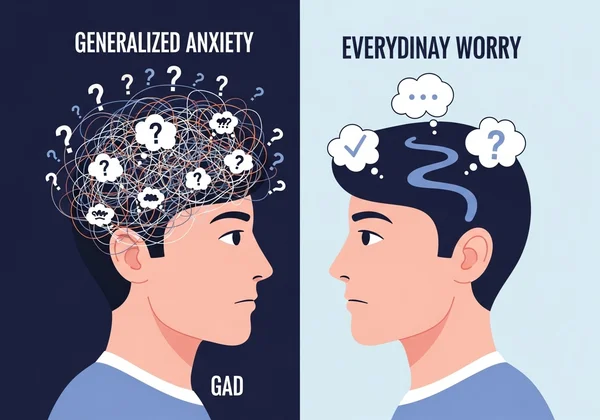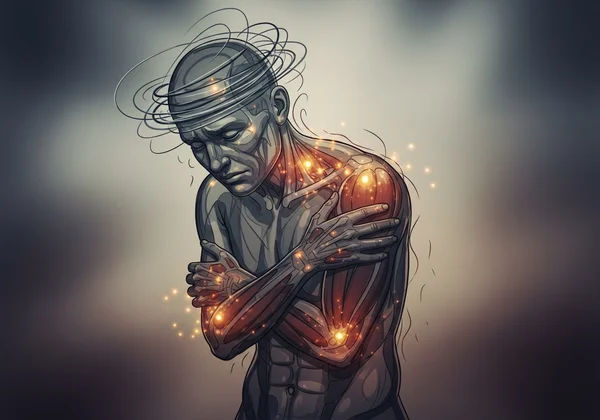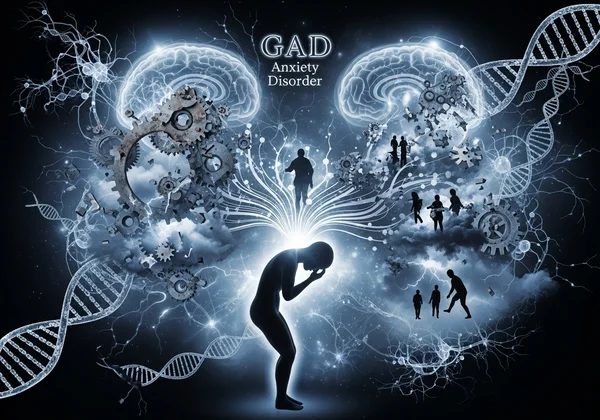Generalized Anxiety Disorder (GAD7): Understanding Symptoms & Online Assessment
Persistent worry can be debilitating. If you're grappling with ongoing anxiety, understanding Generalized Anxiety Disorder (GAD) and the GAD7 assessment is your first step to clarity. This guide will help you understand this common condition, often mistaken for everyday stress, by exploring its distinct symptoms and how they differ from normal worry, along with potential causes and effective treatment paths.
We aim to empower you with knowledge and guide your next steps toward managing anxiety. Understanding your feelings is the first step, and a simple tool can provide clarity. To get a better sense of your own symptoms, you can take a quick assessment on our homepage.
What is Generalized Anxiety Disorder (GAD)?
Generalized Anxiety Disorder is a mental health condition characterized by excessive, uncontrollable, and often irrational worry about everyday things. Unlike a specific phobia where fear is tied to a particular object or situation, GAD involves a pervasive sense of dread that can latch onto various aspects of life, such as health, work, finances, or family.
People with GAD often anticipate disaster and may be overly concerned about minor matters. The key feature is that the intensity, duration, and frequency of the worry are disproportionate to the actual source of concern. This chronic anxiety can significantly interfere with daily functioning and diminish one's quality of life.
GAD vs. Everyday Worry: Key Differences
It's crucial to distinguish between normal, everyday worry and the persistent anxiety associated with GAD. While everyone worries, GAD takes it to another level.
Here are some key differences:
-
Control: People with GAD find it extremely difficult to control their worry. It feels like a constant stream of "what if" scenarios that they can't turn off, whereas typical worry is often manageable.
-
Intensity & Duration: The worry in GAD is more intense, pervasive, and lasts for months on end (a diagnosis typically requires symptoms on most days for at least six months). Everyday worry is usually temporary and tied to a specific, realistic problem.
-
Impact: GAD-related anxiety often disrupts work, school, and social relationships. Everyday worry typically doesn't paralyze you or prevent you from living your life.
-
Physical Symptoms: GAD is frequently accompanied by physical symptoms like fatigue, muscle tension, and sleep problems, which are less common with ordinary stress.

Common GAD Symptoms: More Than Just Feeling Stressed
The experience of GAD is both mental and physical. While the core symptom is excessive worry, it manifests in a variety of ways that go far beyond just feeling stressed out. Recognizing these signs is an important step.
Psychological Symptoms:
- Persistent, uncontrollable worrying about a number of different areas.
- Feeling a sense of impending doom or danger.
- Difficulty concentrating or feeling like your mind "goes blank."
- Irritability and a feeling of being on edge.
- Indecisiveness and fear of making the wrong decision.
Physical Symptoms:
-
Restlessness or inability to relax.
-
Fatigue and feeling easily tired.
-
Muscle tension, aches, or soreness.
-
Sleep disturbances, such as difficulty falling or staying asleep.
-
Headaches, stomachaches, or other unexplained pains.

Understanding the Causes of Generalized Anxiety Disorder
There isn't a single cause for GAD. Instead, it is believed to develop from a complex interplay of various factors. Understanding these potential contributors can help demystify the condition and reduce self-blame. Research suggests that a combination of biological predispositions and life experiences plays a significant role.
If you recognize these patterns in your own life, know that help is available. A great starting point is to understand your anxiety through a confidential self-assessment.
Biological & Genetic Factors in GAD Development
Our brains and bodies can be predisposed to anxiety. Studies show that GAD can run in families, suggesting a genetic component. According to the National Institute of Mental Health, having a close relative with an anxiety disorder can increase your own risk.
Neurobiology also plays a part. Brain imaging studies have shown differences in brain structure and function in individuals with GAD, particularly in areas like the amygdala, which is involved in processing fear and emotion. An imbalance in neurotransmitters—chemical messengers like serotonin and dopamine that regulate mood—is also thought to be a contributing factor.
Environmental & Psychological Triggers for GAD
Life experiences and psychological makeup are critical pieces of the puzzle. Chronic stress, such as working in a high-pressure job or dealing with long-term illness, can contribute to the onset of GAD. Traumatic events, either in childhood or adulthood, can also rewire the brain to be in a constant state of high alert.
Furthermore, certain personality traits, like being timid, pessimistic, or having a tendency to avoid anything potentially dangerous, can make someone more vulnerable. Learned behaviors from family or surroundings can also shape how we respond to stress and perceive threats in the world around us.

Effective GAD Treatment Options & Strategies
The good news is that Generalized Anxiety Disorder is highly treatable. A combination of professional therapy, and in some cases medication, along with self-help strategies, can significantly reduce symptoms and improve quality of life. The journey begins with acknowledging the need for help and exploring the available options.
Disclaimer: This information is for educational purposes only and is not a substitute for professional medical advice. Always consult with a qualified healthcare provider for diagnosis and treatment.
Therapy Approaches for GAD: CBT, ACT & Beyond
Psychotherapy, or "talk therapy," is one of the most effective treatments for GAD. A therapist can help you understand the root of your anxieties and develop new ways of thinking and behaving.
-
Cognitive Behavioral Therapy (CBT): Often considered the gold standard for GAD, CBT helps you identify, challenge, and reframe negative thought patterns. The American Psychological Association highlights its effectiveness in treating anxiety by changing behaviors that contribute to the condition.
-
Acceptance and Commitment Therapy (ACT): ACT uses strategies of acceptance and mindfulness to help you live a fulfilling life despite your anxious thoughts and feelings, rather than trying to eliminate them.

Medication & Complementary Interventions for Anxiety
For some individuals, medication prescribed by a psychiatrist or doctor can be an important part of the treatment plan, often in conjunction with therapy. Medications can help manage the more severe physical and emotional symptoms, making it easier to engage in therapeutic work.
Beyond professional treatment, many complementary practices can support anxiety management. These include:
- Mindfulness and Meditation: These practices train you to stay present and observe your thoughts without judgment.
- Regular Exercise: Physical activity is a powerful, natural anti-anxiety remedy.
- Balanced Diet: Limiting caffeine and processed foods while focusing on whole foods can help stabilize your mood.
Living with GAD: Practical Coping Skills
Learning to manage GAD is an ongoing process that involves developing practical skills for daily life. Creating a "toolkit" of coping strategies can empower you to handle anxiety when it arises. Consider trying a free GAD7 test to get a baseline understanding of your symptoms.
Effective coping skills include:
- Practicing Relaxation Techniques: Deep breathing exercises, progressive muscle relaxation, or yoga can calm your nervous system.
- Prioritizing Sleep: Establish a consistent and relaxing bedtime routine to improve sleep quality.
- Connecting with Others: Sharing your feelings with trusted friends, family, or a support group can reduce feelings of isolation.
- Journaling: Writing down your worries can help externalize them and make them feel more manageable.
Taking Control: Your Path to Managing GAD
Understanding Generalized Anxiety Disorder is the first and most crucial step toward regaining control. Recognizing that your persistent worry is a treatable condition, not a personal failing, opens the door to healing. GAD is complex, stemming from a mix of biology and life experience, but it does not have to define your existence. With the right strategies—from professional therapy and coping skills to lifestyle changes—you can learn to manage your symptoms and lead a full, meaningful life.
If what you've read resonates with you, the next step is to gain more personal insight. A confidential self-assessment can provide a clear, objective snapshot of your current anxiety levels. This simple action can be the start of your journey toward peace and well-being.

Frequently Asked Questions About GAD & the GAD7 Test
What is the GAD7 test and how does it relate to Generalized Anxiety Disorder?
The GAD-7 is a simple, 7-question screening tool designed to help identify probable cases of GAD and measure the severity of anxiety symptoms. It asks about how often you have been bothered by things like feeling nervous, being unable to stop worrying, and feeling afraid over the past two weeks. It's a scientifically validated and widely used first step for individuals and healthcare professionals to quickly assess anxiety levels. You can take the online GAD7 assessment on our site.
Is the GAD7 a diagnostic tool for GAD?
No, the GAD-7 is not a diagnostic tool. It is a screening questionnaire. A high score suggests that you may be experiencing significant anxiety and should speak with a doctor or mental health professional. Only a qualified healthcare provider can conduct a comprehensive evaluation and provide an accurate diagnosis of Generalized Anxiety Disorder or any other condition.
What should I do after taking the GAD7 test?
After you get your GAD7 score, the results will offer a general interpretation of your anxiety level (e.g., mild, moderate, severe). Regardless of the score, if you feel that worry and anxiety are negatively impacting your life, it is always a good idea to discuss your results with a healthcare professional. They can help you understand the next steps, which may include further evaluation, therapy, or other treatment options.
What are the GAD7 score ranges for mild, moderate, or severe anxiety?
The GAD-7 is scored out of 21 points. Generally, the score ranges are interpreted as follows:
- 0-4: Minimal anxiety
- 5-9: Mild anxiety
- 10-14: Moderate anxiety
- 15-21: Severe anxiety These ranges help provide a framework for understanding your symptoms, but a professional's interpretation is essential for context. You can check your symptoms now to see where you fall.